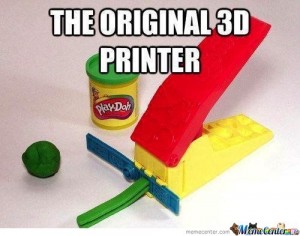
My old letters to Santa used to include things made in big factories in other parts of the country and world. In fact, my kids’ letters to Santa included many of the same types of things. Trains, cars and BB guns were some of those on my list. The allure of those things being made by elves have kept me content for years.
Kids today only have to ask Santa for one thing and they can make just about anything imaginable. For around $300.00 anyone can buy a 3D printer and start manufacturing anything from chess sets to guns. 3D printers are here to stay and as with most technology I’m left asking myself, “what’s next?”
Rather than printing a two dimensional image on paper or other flat media, three dimensional printers use plastic string to compose models. 3D images are dumped to the printer using a computer and voila, minutes to hours later the end result is a three dimensional object. Like everything else, 3D printers come in varying qualities but they all place the ability to create objects in anyone’s hands.
The latest trending news in 3D printers is a group in Texas that created a working plastic firearm. Plans for the device are freely available online which means anyone with a computer and 3D printer can download the plans and have a gun within hours. Though the plastic gun doesn’t look like a traditional firearm, it fires a real bullet using real gun powder.
What spews out of 3D printers is limited only by the user’s imagination. Industrial manufacturers use this technology for prototyping designs. Consumers use 3D printers for making devices that solve household problems. Apparently anyone who has access to one of these can even make guns.
Within the next few months I suspect metal based 3D printers to start surfacing which will allow greater flexibility with regard to end products. The patent for sintering, the technology that makes metal printing possible, is due to expire relatively soon. I’m not a metallurgist but I suspect the end product will also have limitations.
Back in my industrial days I remember prototyping products and the cost associated with manufacturing a one-of-a-kind item. Making one piece always cost more because it involved dedicating a machine and man hours to the process. In industry 3D printing allows an engineer or designer to fabricate a part and work the kinks out of it prior to making the final prototype.
At home, 3D printing allows homeowners and tinkerers to create unique solutions to everyday problems. Rather than modify an existing product, anyone can make a new one from scratch. The possibilities are endless; from new paperclips to designer door stops, anyone can make anything.
No matter who uses a 3D printer there are some required basics I didn’t mention earlier. First, of course, is a computer. Computers don’t do anything without software, so good 3D design software will compliment the printer. And finally, users will need a fair amount of patience while they wait for their creation to finish.
In the future Santa may stop making toys and just focus on 3D printers. I know if I managed a shop with tens of thousands of workers I’d be inclined to focus my energy. We’ve come to a point when owning a device that actually creates a product from a picture is no longer fiction. After seeing these in action I’m not too sure what lies in our future.
(Jeromy Patriquin is the President of Laptop & Computer Repair, Inc. located at 509 Main St. in Gardner. You can call him at (978) 919-8059 or visit www.LocalComputerWiz.com.)
